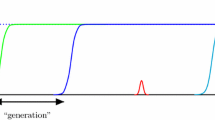Abstract
Deepening our understanding of the characteristics and behaviors of population-based search algorithms remains an important ongoing challenge in Evolutionary Computation. To date however, most studies of Evolutionary Algorithms have only been able to take place within tightly restricted experimental conditions. For instance, many analytical methods can only be applied to canonical algorithmic forms or can only evaluate evolution over simple test functions. Analysis of EA behavior under more complex conditions is needed to broaden our understanding of this population-based search process. This paper presents an approach to analyzing EA behavior that can be applied to a diverse range of algorithm designs and environmental conditions. The approach is based on evaluating an individual’s impact on population dynamics using metrics derived from genealogical graphs. From experiments conducted over a broad range of conditions, some important conclusions are drawn in this study. First, it is determined that very few individuals in an EA population have a significant influence on future population dynamics with the impact size fitting a power law distribution. The power law distribution indicates there is a non-negligible probability that single individuals will dominate the entire population, irrespective of population size. Two EA design features are however found to cause strong changes to this aspect of EA behavior: (1) the population topology and (2) the introduction of completely new individuals. If the EA population topology has a long path length or if new (i.e. historically uncoupled) individuals are continually inserted into the population, then power law deviations are observed for large impact sizes. It is concluded that such EA designs can not be dominated by a small number of individuals and hence should theoretically be capable of exhibiting higher degrees of parallel search behavior.
Similar content being viewed by others
References
Goldberg DE, Deb K (1991) A Comparative Analysis of Selection Schemes Used in Genetic Algorithms. Urbana 51: 61801–2996
Blickle T (1996) Theory of evolutionary algorithms and application to system synthesis. Swiss Federal Institute of Technology
Wieczorek W, Czech ZJ (2002) Selection schemes in evolutionary algorithms. In: Proceedings of the symposium on intelligent information systems (IIS’2002), pp 185–194
Van Nimwegen E, Crutchfield JP (2001) Optimizing epochal evolutionary search: population-size dependent theory. Mach Learn 45: 77–114
Smith T, Husbands P, O’Shea M (2003) Local evolvability of statistically neutral GasNet robot controllers. Biosystems 69: 223–243
Nijssen S, Back T (2003) An analysis of the behavior of simplified evolutionary algorithms on trap functions. IEEE Trans Evol Comput 7: 11–22
Davis L (1991) Handbook of genetic algorithms: Van Nostrand Reinhold, New York
Julstrom BA (1995) What have you done for me lately? Adapting operator probabilities in a steady-state genetic algorithm. In: Proceedings of the sixth international conference on genetic algorithms, pp 81–87
Julstrom BA (1997) Adaptive operator probabilities in a genetic algorithm that applies three operators. In: ACM symposium on applied computing (SAC’97), pp 233–238
Whitacre JM, Pham TQ, Sarker RA (2006) Credit assignment in adaptive evolutionary algorithms. In: Proceedings of the eigth annual genetic and evolutionary computation conference, pp 1353–1360
Whitacre JM (2007) Adaptation and self-organization in evolutionary algorithms. Thesis, University of New South Wales, p 283
Mahfoud SW (1995) A comparison of parallel and sequential Niching methods. Conf Genetic Algorithms 136: 143
Pfaffelhuber P, Lehnert A, Stephan W (2008) Linkage disequilibrium under genetic hitchhiking in finite populations. Genetics 179: 527
Hedrick PW (2007) Genetic hitchhiking: a new factor in evolution? Bioscience 32
Félix MA, Wagner A (2008) Robustness and evolution: concepts, insights and challenges from a developmental model system. Heredity 100: 132–140
Wagner A (2008) Neutralism and selectionism: a network-based reconciliation. Nat Rev Genet
Gibson G, Dworkin I (2004) Uncovering cryptic genetic variation. Nat Rev Genet 5: 681–690
Schlichting CD (2008) Hidden reaction norms, cryptic genetic variation, and evolvability. Ann N Y Acad Sci 1133: 187–203
Hermisson J, Wagner GP (2004) The population genetic theory of hidden variation and genetic robustness. Genetics 168: 2271–2284
Bergman A, Siegal ML (2003) Evolutionary capacitance as a general feature of complex gene networks. Nature 424: 549–552
Hartman JL, Garvik B, Hartwell L (2001) Principles for the buffering of genetic variation. Science 291: 1001–1004
Wright AH (1990) Genetic algorithms for real parameter optimization. In: First workshop on the foundations of genetic algorithms and classifier systems, pp 205–218
Author information
Authors and Affiliations
Corresponding author
Rights and permissions
About this article
Cite this article
Whitacre, J.M., Sarker, R.A. & Pham, Q.T. Making and breaking power laws in evolutionary algorithm population dynamics. Memetic Comp. 1, 125–137 (2009). https://doi.org/10.1007/s12293-009-0009-8
Received:
Accepted:
Published:
Issue Date:
DOI: https://doi.org/10.1007/s12293-009-0009-8




